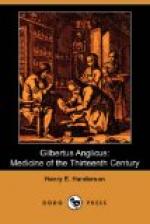to make water. If this treatment turns out in
accordance with your theory, the urine necessarily
escapes and your idea and treatment are confirmed.
If, however, the urine not escape, let the boy be
shaken vigorously a second time. If this too
fails and strangury ensues, it will be necessary to
resort to the use of a sound or catheter (
argaliam),
so that when the stone is pushed away from the neck
of the bladder the passage may be opened and the urine
may flow out. It may be possible too that no
stone exists, but the urethra is obstructed or closed
by pure coagulated blood. Perhaps there may have
been a wound of the bladder, although no external
haemorrhage has appeared, but the blood coagulating
gradually in the bladder has occasioned an obstruction
or narrowing of the urinary passage. Or possibly
the blood from a renal haemorrhage has descended into
the bladder and obstructs the urethra. Hence
I say that the sound is useful in these cases where
the urethra is obstructed by blood or gross humors.
Examination should also be made as to whether a fleshy
body exists in the bladder, as the result of some
wound. This condition is manifest if, on the introduction
of the sound, the urine flows out promptly. I
once saw a man suffering from this condition, who
complained of severe pain in the urinary passage as
I was introducing the sound, and I recognized that
there were wounds in the same part, for as soon as
these were touched by the sound the urine began to
flow, followed soon after by a little blood and fleshy
particles.... So far as the operation of physicians
is concerned, it is necessary only to be certain of
the fact that obstruction to the passage of urine
depends upon no other cause than stone or the presence
of coagulated blood (f. 271).
Gilbert’s medical treatment of vesical calculus
consists generally in the administration of diuretics
and lithontriptics and the local application of poultices,
plasters and inunctions of various kinds. Of
the lithontriptics, certain combinations, characterized
by famous names or notable historical origin, are
evident favorites. Among this class we read of
the Philoantropos major and minor, the
Justinum, the Usina “approved by
many wise men of Babylon and Constantinople,”
the Lithontripon and the “Pulvis Eugenii
pape,” with numerous others.
Rather curiously and suggestively no mention is made
in this immediate connection of the technique of lithotomy.
On a later page, however (f. 309a), we find a chapter
entitled “De cura lapidis per cyrurgiam,”
in which Gilbert writes:




